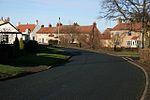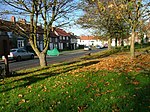Deighton, Hambleton
Civil parishes in North YorkshireHambleton District geography stubsUse British English from March 2018Villages in North Yorkshire

Deighton is a village and civil parish in the Hambleton District of North Yorkshire, England. It is about 6 miles (9.7 km) north of Northallerton and near the A167 road. A moated site at grid reference NZ379017 in Deighton is a scheduled ancient monument. In the 2011 census, the population of Deighton (including Little Smeaton and Birkby) was 168.
Excerpt from the Wikipedia article Deighton, Hambleton (License: CC BY-SA 3.0, Authors, Images).Deighton, Hambleton
Waver Lane,
Geographical coordinates (GPS) Address Nearby Places Show on map
Geographical coordinates (GPS)
| Latitude | Longitude |
|---|---|
| N 54.40935 ° | E -1.41759 ° |
Address
Waver Lane
Waver Lane
DL6 2SJ
England, United Kingdom
Open on Google Maps











